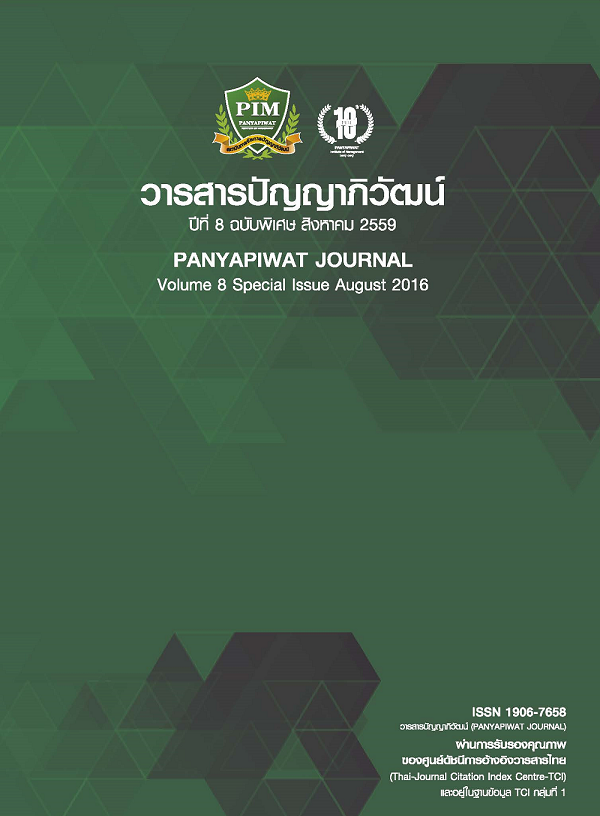ผลกระทบของนโยบายการแทรกแซงราคาและเขตเสรีการค้าต่อยางพารา: กรณีศึกษาประเทศไทย
Main Article Content
บทคัดย่อ
ยางพาราเป็นหนึ่งในสินค้าเกษตรที่มีความสำคัญต่อประเทศไทย รัฐบาลให้ความสำคัญกับยางพาราด้วยการดำเนินนโยบายแทรกแซงตลาดยางพารามาตลอด บทความชิ้นนี้มีวัตถุประสงค์ที่จะตรวจสอบผลกระทบของการดำเนินนโยบายแทรกแซงราคาต่อการส่งออกยางพาราและราคายางพารา นอกจากนี้ บทความนี้ยังมีวัตถุประสงค์ที่จะตรวจสอบผลกระทบของปัจจัยระดับระหว่างประเทศ (การเปิดเขตเสรีการค้าอาเซียนและการร่วมมือระหว่างประเทศผู้ส่งออกยางพารา) ต่อการส่งออกและราคายางพารา ผลการศึกษาพบว่า นโยบายแทรกแซงราคายางพารานำไปสู่การเพิ่มขึ้นของปริมาณการส่งออกยางพารา ในขณะที่การเปิดเสรีทางการค้าอาเซียนนำไปสู่การลดลงของปริมาณการส่งออกยางพารา ส่วนนโยบายการแทรกแซงราคาและการเปิดเสรีทางการค้าอาเซียนไม่มีผลกระทบต่อราคายางพาราภายในประเทศ ดังนั้น รัฐบาลควรให้ความสำคัญกับการดำเนินนโยบายแทรกแซงราคายางพารา กำหนดและดำเนินนโยบายที่ป้องกันผลกระทบของการเปิดเสรีทางการค้าอาเซียนต่อภาคยางพารา
Rubber is one of the most important agricultural commodities of Thailand. The government has put a significance on the sector by always implementing a price intervention policy. This paper was aimed to examine the impact of price intervention policy implementation on rubber exports and rubber price. Moreover, it was aimed to examine the impact of international-level factors (ASEAN Free Trade Area and cooperation of rubber-exporting countries) on the rubber exports and rubber price. The findings showed that the price intervention policy led to increase of rubber export volumes. Meanwhile, the price intervention policy led to decrease of rubber export volumes. The price intervention policy and ASEAN Free Trade Area did not have a significant impact on the rubber price. Therefore, the government should pay attention on implementing the price intervention policy, and it should give a significance on implementing the price intervention policy, and it should formulate and implement policies that can prevent an impact of ASEAN Free Trade Area on the rubber sector.
Article Details
“ข้าพเจ้าและผู้เขียนร่วม (ถ้ามี) ขอรับรองว่า บทความที่เสนอมานี้ยังไม่เคยได้รับการตีพิมพ์และไม่ได้อยู่ระหว่างกระบวนการพิจารณาลงตีพิมพ์ในวารสารหรือแหล่งเผยแพร่อื่นใด ข้าพเจ้าและผู้เขียนร่วมยอมรับหลักเกณฑ์การพิจารณาต้นฉบับ ทั้งยินยอมให้กองบรรณาธิการมีสิทธิ์พิจารณาและตรวจแก้ต้นฉบับได้ตามที่เห็นสมควร พร้อมนี้ขอมอบลิขสิทธิ์บทความที่ได้รับการตีพิมพ์ให้แก่สถาบันการจัดการปัญญาภิวัฒน์หากมีการฟ้องร้องเรื่องการละเมิดลิขสิทธิ์เกี่ยวกับภาพ กราฟ ข้อความส่วนใดส่วนหนึ่งและ/หรือข้อคิดเห็นที่ปรากฏในบทความข้าพเจ้าและผู้เขียนร่วมยินยอมรับผิดชอบแต่เพียงฝ่ายเดียว”
เอกสารอ้างอิง
การยางแห่งประเทศไทย. (2557). การเคลื่อนไหวราคายางประเภทต่างๆ. สืบค้นเมื่อ 8 ตุลาคม 2557, จาก http://www.rubber.co.th/rubber2012/menu5.php
ธนพันธ์ ไล่ประกอบทรัพย์. (2556ก). ผลกระทบของโครงการอุดหนุนสินค้าเกษตรระยะสั้นต่อการส่งออกและการผลิตข้าวไทย. รายงานวิจัย คณะรัฐประศาสนศาสตร์ สถาบันบัณฑิตพัฒนบริหารศาสตร์.
ธนพันธ์ ไล่ประกอบทรัพย์. (2556ข). ระบบการเมือง การพัฒนาเศรษฐกิจ กับนโยบายอุดหนุนสินค้าเกษตรของไทย. วารสารบัณฑิตศึกษามนุษยศาสตร์และสังคมศาสตร์ มหาวิทยาลัยขอนแก่น, 2(1), 81-98.
นลินี ประทุม. (2550). การวิเคราะห์ความเคลื่อนไหวการพยากรณ์มูลค่าส่งออกมันสำปะหลังของไทย. ปัญหาพิเศษ คณะเศรษฐศาสตร์ มหาวิทยาลัยเชียงใหม่.
ปวีณา พันธ์กล้า. (2551). การศึกษาการส่งผ่านราคามันสำปะหลังของไทยก่อนและหลังการเปิดเสรีการค้า ASEAN-China. วิทยาศาสตรมหาบัณฑิต (เศรษฐศาสตร์เกษตร) มหาวิทยาลัยเกษตรศาสตร์.
ปุญธิดา ศรีเขียวใส. (2554). การวิเคราะห์ความผันผวนของอัตราผลตอบแทนของราคาปัจจุบันยางพาราของประเทศในเอเชียตะวันออกเฉียงใต้. เศรษฐศาสตรมหาบัณฑิต มหาวิทยาลัยเชียงใหม่.
สวย หลักเมือง. (2558). แนวทางการจัดการปัญหาวิถีการตลาดของกลุ่มเกษตรกรข้าวสังข์หยด. วารสารปัญญาภิวัฒน์, 7(3), 37-50.
สำนักเลขาธิการคณะรัฐมนตรี. (2557). นโยบายของรัฐบาลเกี่ยวกับยางพารา. สืบค้นเมื่อ 8 ตุลาคม 2557, จาก http://www.cabinet.soc.go.th/soc/Program2-2.jsp? key_word=%C2%D2%A7%BE%D2%C3%D2&meet_date_dd=&meet_date_mm=&meet_date_yyyy=&meet_date_dd2=&meet_date_mm2=&meet_date_yyyy2=&doc_id1=&doc_id2=&owner_dep=&Input=+%A4%E9%B9%CB%D2+
Sang, W. (2555). การวิเคราะห์ความผันผวนของผลตอบแทนของราคายางพารา. เศรษฐศาสตรดุษฎีบัณฑิต มหาวิทยาลัยเชียงใหม่.
Anderson, K. & Martin, W. (2009). Distortions to agricultural incentives in Asia. Washington, D.C.: The International Bank for Reconstruction and Development/The World Bank.
Bates, R. H. (1997). Open-economy political economy of the world coffee Trade. Princeton, NJ: Princeton University Press.
Binswanger, H. P. & Deininger, K. (1997). Explaining agricultural and agrarian policies in developing countries. Journal of Economic Literature, 35(4), 1958-2005.
Breusch, T. S. (1978). Testing for autocorrelation in dynamic linear models. Australian Economic Papers, 17(31), 334-355.
Durbin, J. & Watson, G. S. (1950). Testing for serial correlation in least square regression: II. Biometrika, 38(1/2), 159-177.
Godfrey, L. G. (1978). Testing against general autoregressive and moving average error models when the regressors include lagged dependent variables. Econometrica, 46, 1293-1301.
Index Mundi. (2013). Rubber monthly price – US cents per pound. Retrieved October 15, 2014, from http://www.indexmundi.com/commodities/?commodity=rubber&months=360
Kasara, K. (2007). Tax me if you can: Ethnic geography, democracy, and the taxation of agriculture in Africa. American Political Science Review, 101(1), 159-172.
Krueger, A. O. (1991). The political economy of agricultural pricing policy: The synthesis. Baltimore, MD: The World Bank and The Johns Hopkins University Press.
Krueger, A. O. (1992). The political economy of agricultural pricing policy: The synthesis. Baltimore, MD: The World Bank and The Johns Hopkins University Press.
Laiprakobsup, T. (2014). “Populism and agricultural trade in developing countries: A case study of Thailand’s rice pledging scheme.” International Review of Public Administration, 19(4), 380-394.
Ramsey, J. B. (1969). Tests for specification errors in classical linear least squares regression analysis. Journal of the Royal Statistical Society: Series A (General),132(4), 598-611.
Varshney, A. (1995). Democracy, development, and the countryside: Urban-rural struggles in India. New York: Cambridge University Press.
Translated Thai References
Laiprakobsup, T. (2013A). Impact of short-term agricultural subsidy program on rice exports and production. Research report, Graduate School of Public Administration, National Institute of Development Administration. [in Thai]
Laiprakobsup, T. (2013B). Political system, economic development, and Thai agricultural subsidy policy. Journal of Graduate Study in Humanities and Social Sciences Khonkean University,2(1), 81-98.[in Thai]
Lakmuang, S. (2015). Means for solving market problems of Sangyod brown rice farmers’ groups. Panyapiwat Journal, 7(3), 37-50. [in Thai]
Pankra, P. (2008). A study of transfer of Thai cassava price before and after ASEAN-China free trade area. Master Thesis, Kasetsart University. [in Thai]
Prathum, N. (2007). An analysis of prediction of movement of Thai cassava-export values. Special problem, Faculty of Economics, Chiangmai University. [in Thai]
Rubber Authority of Thailand. (2014). Price movement of several rubber types. Retrieved October 8, 2014, from http://www.rubber.co.th/rubber2012/menu5.php [in Thai]
Sang, W. (2012). An analysis of fluctuation of returns of rubber price. Doctoral Dissertation, Chiangmai University. [in Thai]
Secretariat of the Cabinet. (2014). Government’s rubber policy. Retrieved October 8, 2014, from http://www.cabinet.soc.go.th/soc/Program2-2.jsp?key_word=%C2%D2%A7%BE%D2%C3%D2&meet_date_dd=&meet_date_mm=&meet_date_yyyy=&meet_date_dd2=&meet_date_mm2=&meet_date_yyyy2=&doc_id1=&doc_id2=&owner_dep=&Input=+%A4%E9%B9%CB%D2+ [in Thai]
Srikaewsai, P. (2011). An analysis of a fluctuation of returns of current rubber price in Southeast Asian countries. Master Thesis, Chiangmai University. [in Thai]


